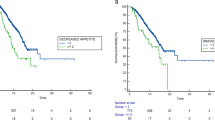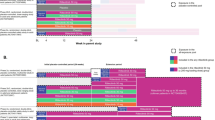Abstract
The cardiovascular (CV) toxicity profiles of traditional cancer therapies such as anthracyclines and radiation therapy are familiar to many cardiologists. With the development and widespread use of additional cancer therapeutics, CV toxicities related to these agents are becoming more common. Cardiovascular specialists are often integrated into the care team for individuals with cancer and knowledge of the CV toxicities of cancer therapeutics has become essential. In this review, we provide a clinically focused summary of the current data regarding CV toxicities of common cancer therapies and identify potential management strategies for the CV specialist.
Similar content being viewed by others
Abbreviations
- ADT:
-
Androgen deprivation therapy
- BP:
-
Blood pressure
- CML:
-
Chronic myeloid leukemia
- CTLA-4:
-
Cytotoxic T-lymphocyte-associated antigen 4
- CV:
-
Cardiovascular
- FDA:
-
Food and Drug Administration
- GnRH:
-
Gonadotropin releasing receptor hormone
- HTN:
-
Hypertension
- ICI:
-
Immune checkpoint inhibitors
- PD-1:
-
Programmed death -1
- PDL-1:
-
Programmed death ligand- 1
- PI:
-
Proteasome inhibitors
- TKI:
-
Tyrosine kinase inhibitors
- VEGFi:
-
Vascular endothelial growth factor inhibitors
References
Hodi FS et al (2010) Improved survival with ipilimumab in patients with metastatic melanoma. N Engl J Med 363(8):711–723
Ribas A (2012) Tumor immunotherapy directed at PD-1. N Engl J Med 366(26):2517–2519
Hu JR et al (2019) Cardiovascular toxicities associated with immune checkpoint inhibitors. Cardiovasc Res 115(5):854–868
Salem JE et al (2018) Cardiovascular toxicities associated with immune checkpoint inhibitors: an observational, retrospective, pharmacovigilance study. Lancet Oncol 19(12):1579–1589
Johnson DB et al (2016) Fulminant myocarditis with combination immune checkpoint blockade. N Engl J Med 375(18):1749–1755
Wang DY et al (2018) Fatal toxic effects associated with immune checkpoint inhibitors: a systematic review and meta-analysis. JAMA Oncol 4(12):1721–1728
Moslehi JJ et al (2018) Increased reporting of fatal immune checkpoint inhibitor-associated myocarditis. Lancet 391(10124):933
Daxini A, Cronin K, Sreih AG (2018) Vasculitis associated with immune checkpoint inhibitors—a systematic review. Clin Rheumatol 37(9):2579–2584
Clavijo CS et al (2020) Cardiovascular complications of chimeric antigen receptor T-cell therapy: the cytokine release syndrome and associated arrhythmias. J Immunother Precis Oncol 3(3):113–120
Aldoss I et al (2019) Cytokine release syndrome with the novel treatments of acute lymphoblastic leukemia: pathophysiology, prevention, and treatment. Curr Oncol Rep 21(1):4
Linette GP et al (2013) Cardiovascular toxicity and titin cross-reactivity of affinity-enhanced T cells in myeloma and melanoma. Blood 122(6):863–871
Buckley LF, Abbate A (2018) Interleukin-1 blockade in cardiovascular diseases: a clinical update. Eur Heart J 39(22):2063–2069
Cancer Stat Facts: Kidney and Renal Pelvis Cancer (2019). https://seer.cancer.gov/statfacts/html/kidrp.html. Accessed 5 Jan 2020
Nguyen PL et al (2011) Association of androgen deprivation therapy with cardiovascular death in patients with prostate cancer: a meta-analysis of randomized trials. JAMA 306(21):2359–2366
D’Amico AV et al (2015) Long-term follow-up of a randomized trial of radiation with or without androgen deprivation therapy for localized prostate cancer. JAMA 314(12):1291–1293
Gupta D et al (2018) Cardiovascular and metabolic effects of androgen-deprivation therapy for prostate cancer. J Oncol Pract 14(10):580–587
Keating NL, O’Malley AJ, Smith MR (2006) Diabetes and cardiovascular disease during androgen deprivation therapy for prostate cancer. J Clin Oncol 24(27):4448–4456
Hu JR et al (2020) Cardiovascular effects of androgen deprivation therapy in prostate cancer: contemporary meta-analyses. Arterioscler Thromb Vasc Biol 40(3):e55–e64
Shore ND et al (2020) Oral relugolix for androgen-deprivation therapy in advanced prostate cancer. N Engl J Med 382(23):2187–2196
Moreira RB et al (2017) Differential side effects profile in patients with mCRPC treated with abiraterone or enzalutamide: a meta-analysis of randomized controlled trials. Oncotarget 8(48):84572–84578
Iacovelli R et al (2018) The cardiovascular toxicity of abiraterone and enzalutamide in prostate cancer. Clin Genitourin Cancer 16(3):e645–e653
Salem JE et al (2019) Androgenic effects on ventricular repolarization: a translational study from the international pharmacovigilance database to iPSC-cardiomyocytes. Circulation 140(13):1070–1080
Li W et al (2015) Vascular and metabolic implications of novel targeted cancer therapies: focus on kinase inhibitors. J Am Coll Cardiol 66(10):1160–1178
Eremina V et al (2008) VEGF inhibition and renal thrombotic microangiopathy. N Engl J Med 358(11):1129–1136
Lankhorst S et al (2014) Hypertension during vascular endothelial growth factor inhibition: focus on nitric oxide, endothelin-1, and oxidative stress. Antioxid Redox Signal 20(1):135–145
Veronese ML et al (2006) Mechanisms of hypertension associated with BAY 43-9006. J Clin Oncol 24(9):1363–1369
Mourad JJ et al (2008) Blood pressure rise following angiogenesis inhibition by bevacizumab. A crucial role for microcirculation. Ann Oncol 19(5):927–934
Belcik JT et al (2012) Cardiovascular and systemic microvascular effects of anti-vascular endothelial growth factor therapy for cancer. J Am Coll Cardiol 60(7):618–625
Maitland ML et al (2010) Initial assessment, surveillance, and management of blood pressure in patients receiving vascular endothelial growth factor signaling pathway inhibitors. J Natl Cancer Inst 102(9):596–604
Kerkela R et al (2006) Cardiotoxicity of the cancer therapeutic agent imatinib mesylate. Nat Med 12(8):908–916
Hatfield A, Owen S, Pilot PR (2007) In reply to ‘Cardiotoxicity of the cancer therapeutic agent imatinib mesylate’. Nat Med 13(1):15–16
Shah NP et al (2016) Dasatinib in imatinib-resistant or -intolerant chronic-phase, chronic myeloid leukemia patients: 7-year follow-up of study CA180-034. Am J Hematol 91(9):869–874
Hochhaus A et al (2016) Long-term benefits and risks of frontline nilotinib vs imatinib for chronic myeloid leukemia in chronic phase: 5-year update of the randomized ENESTnd trial. Leukemia 30(5):1044–1054
Cortes JE et al (2018) Ponatinib efficacy and safety in Philadelphia chromosome-positive leukemia: final 5-year results of the phase 2 PACE trial. Blood 132(4):393–404
Hadzijusufovic E et al (2017) Nilotinib-induced vasculopathy: identification of vascular endothelial cells as a primary target site. Leukemia 31(11):2388–2397
Pouwer MG et al (2018) The BCR-ABL1 inhibitors imatinib and ponatinib decrease plasma cholesterol and atherosclerosis, and nilotinib and ponatinib activate coagulation in a translational mouse model. Front Cardiovasc Med 5:55
Manouchehri A et al (2020) Tyrosine kinase inhibitors in leukemia and cardiovascular events: from mechanism to patient care. Arterioscler Thromb Vasc Biol 40(2):301–308
Dimopoulos MA et al (2017) Carfilzomib or bortezomib in relapsed or refractory multiple myeloma (ENDEAVOR): an interim overall survival analysis of an open-label, randomised, phase 3 trial. Lancet Oncol 18(10):1327–1337
Cole DC, Frishman WH (2018) Cardiovascular complications of proteasome inhibitors used in multiple myeloma. Cardiol Rev 26(3):122–129
Hasinoff BB, Patel D, Wu X (2017) Molecular mechanisms of the cardiotoxicity of the proteasomal-targeted drugs bortezomib and carfilzomib. Cardiovasc Toxicol 17(3):237–250
Cornell RF et al (2019) Prospective study of cardiac events during proteasome inhibitor therapy for relapsed multiple myeloma. J Clin Oncol 37(22):1946–1955
Chari A, Hajje D (2014) Case series discussion of cardiac and vascular events following carfilzomib treatment: possible mechanism, screening, and monitoring. BMC Cancer 14:915
Chari A et al (2018) Analysis of carfilzomib cardiovascular safety profile across relapsed and/or refractory multiple myeloma clinical trials. Blood Adv 2(13):1633–1644
Diwadkar S, Patel AA, Fradley MG (2016) Bortezomib-induced complete heart block and myocardial scar: the potential role of cardiac biomarkers in monitoring cardiotoxicity. Case Rep Cardiol 2016:3456287
Acknowledgements
This publication is supported in part by the To-morrow’s Research Fund St. Baldrick’s Scholar Award (Award Number 636214). The content is solely the responsibility of the authors and does not necessarily represent the official views of St. Baldrick’s Foundation. This publication is supported in part by the American Heart Association (Award Number 19CDA34760181). The content is solely the responsibility of the authors and does not necessarily represent the official views of the American Heart Association.
Author information
Authors and Affiliations
Corresponding author
Ethics declarations
Conflict of interest
The authors declare that they have no conflict of interests.
Additional information
Publisher's Note
Springer Nature remains neutral with regard to jurisdictional claims in published maps and institutional affiliations.
Rights and permissions
About this article
Cite this article
Bottinor, W., Parikh, A. & Jahangir, E. Emerging cancer therapies and cardiovascular risk. J Thromb Thrombolysis 51, 837–845 (2021). https://doi.org/10.1007/s11239-020-02263-9
Published:
Issue Date:
DOI: https://doi.org/10.1007/s11239-020-02263-9







